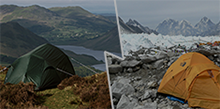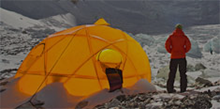Warm Nights and A Lighter Pack, Wherever, Whenever





-
Use it as part of your sleeping gear and you can cut your bag weight dramatically, maybe in half, and still be warm.
Here’s an actual example from the high Himalayas:Sleep system used at top camp on broad peak and equivalent bags (all rated for -32°C) PACKWEIGHT Sleep System:Hispar Overbag + Xero Down Suit820g* Traditional single bag:Hispar 8001290g Traditional single bag:Diamir 9001740g * Xero Down Suit worn during the day.And another actual example from Scotland:SLEEP SYSTEM USED ON ISLE OF ARRAN AND EQUIVALENT BAG RATED FOR 2°C PACKWEIGHT Sleep System:Ultra Bag + Wafer top, trousers & socks375g* Traditional single bag:PHD lightweight 'Design Your Own' sleeping bag550g * Wafer jacket and trousers worn during the day. -
One main sleeping bag plus down clothing (or a Filler or Overbag) means multiple options from the same kit.
Sleep Systems offers new possibilities in so many situations as Sam Cook describes in this case study.
One light bag can cover a temperature range which would normally call for 3 different bags:
SLEEP SYSTEMS SEPARATE SLEEPING BAGS Scotland -5°C Hispar 400 bag Hispar 400 bag Everest Base Camp -15°C Hispar 400 bag + Ultra clothing Hispar 500 bag Aconcagua -25°C Hispar 400 bag + Hispar clothing Diamir 900 bag And see how an overbag doesn't just double your options, it trebles them.
-
Stowability is a real plus for kayakers and bikers as well as campers and climbers.
Find out more how Martin Rickard used a PHD sleep system on a kayak expedition to Greenland.

-
Use it as part of your sleeping gear and you can cut your bag weight dramatically, maybe in half, and still be warm.
Does carrying a lighter bag mean sacrificing comfort and even a degree of safety? Not at all. Put together a good system and you can have all the benefits including comfort and safety.
It’s definitely more comfortable to have your down jacket on already when you get up on a cold morning. And in more serious situations is it safer to be faced with climbing out of your big bag and struggling into your down gear when the storm starts to take your tent apart? Or is it better to be ready simply to get up and deal with it?
Sleep Systems for Comfort:
- This Case Study shows how Sleep Systems is an ultralight way to add comfort to a standard sleeping bag when needed.
- This Case Study shows how Sleep Systems clothing adds comfort in camp.
Sleep Systems for Safety:
- This Case Study describes how, when sleeping at -21°C, Peter Hutchinson found that down clothing boosted his ultralight bag overnight, but also kept him warm when he had to move around.
- This Case Study explains how Sleep Systems allowed Martin Rickard to pack two small bags that could be stowed separately to prevent wetting while kayaking.
New dimensions for an old idea
Smart lightweight campers have been using their clothes to boost the warmth of their sleeping bags for years and climbers do it when they have to. Yet most of us are still carrying bags much bulkier and heavier than we need.
Now PHD Sleep Systems opens a whole new level of possibilities. It links together the unique warmth/weight performance of all our down gear along with the new designs we have created specifically to expand the potential of this powerful idea.
Sleep Systems lays it all out for you, a clear universal framework that works for any night outdoors anywhere, covering the whole range from valley camping to top camp on an 8000 metre peak.
Take a look and see how you can do a great deal more with less.
Recommended Sleep Systems
How Sleep Systems works
- Main Sleeping Bag
Naturally the main bag will be at the heart of your Sleep System. The six PHD bags we recommend all score 'best in the world' in warmth for weight, the perfect base to build your system on. All are fully customisable, including for width (an essential option for some systems). The basic ratings for these bags vary from +8°C for the Ultra to -21°C for the Hispar 600. They are all from the lightweight half of PHD’s sleeping bag range, but use them in combination with the other elements of Sleep Systems and they will keep you warm anywhere on earth.
- Main Sleeping Bag+ YOUR Clothing
Clothing is the most efficient weight-saver in Sleep Systems. Use the warmth of your down clothing to sleep in and you can really cut down the weight and bulk of your main bag. It works just as well in the high Himalayas as in a lightweight camp in the UK.Our Case Studies from Broad Peak (8051m), from a test in an industrial Cold Store, and from Arran, Scotland all illustrate this well.
Note about legs & feet: As this Case Study describes, it's important not to ignore your lower half. Cold legs or feet will stop you sleeping. So the clothing we recommend for Sleep Systems is a complete body set e.g. Minimus clothing means a Minimus jacket + down trousers & down socks -- and of course down trousers and socks have their own uses around camp. You can omit lower half items from your system, but the temperature ratings will not hold good if applied to only half the body.
- Main Sleeping Bag+ Jacket and Halfbag
This is an alternative system, which protects legs and feet with a simple halfbag (a short down bag coming up to the waist which overlaps with your jacket at the waist). A halfbag is an effective option and a useful item for a bivvy (intentional or not), but it doesn’t offer warmth on the move like down trousers. As this Case Study describes, you can of course omit lower half items from your system, but the temperature ratings will not hold good if applied to only half the body.
- Main Sleeping Bag+ Filler bag
The Filler bag is a PHD speciality we have developed over the last few years, the lightest form of booster for your main sleeping bag. Unlike Overbags the Filler bag works from the inside, filling the random airspaces inside the main bag and cutting out the convection currents. It's very light, very comfortable, and provides insulation for the whole body. The Filler bag will extend the performance of your main bag by about 10°C and is slightly more efficient than an Overbag (warmth for weight). These three Case Studies from Scotland, Wales, and Yorkshire Dales describe the Filler in action.
- Main Sleeping Bag+ Overbag
Overbags are the big guns in Sleep Systems. As the name says, they fit over your main bag and increase the warmth, most of them by well over 20°C. PHD have a lot of experience with overbags, having made them for polar travel, high mountains and winter camping for years. An overbag will convert your lightweight summer bag into a year round performer and give you a midway option too. For example the standalone rating for a Minimus bag is 5°C and for a Minim Combi overbag it’s -5°C. Put them together and the system will cope with -18°C. These three Case Studies from the high Himalayas, Scotland in Winter, and Greenland describe Overbags in action.



















